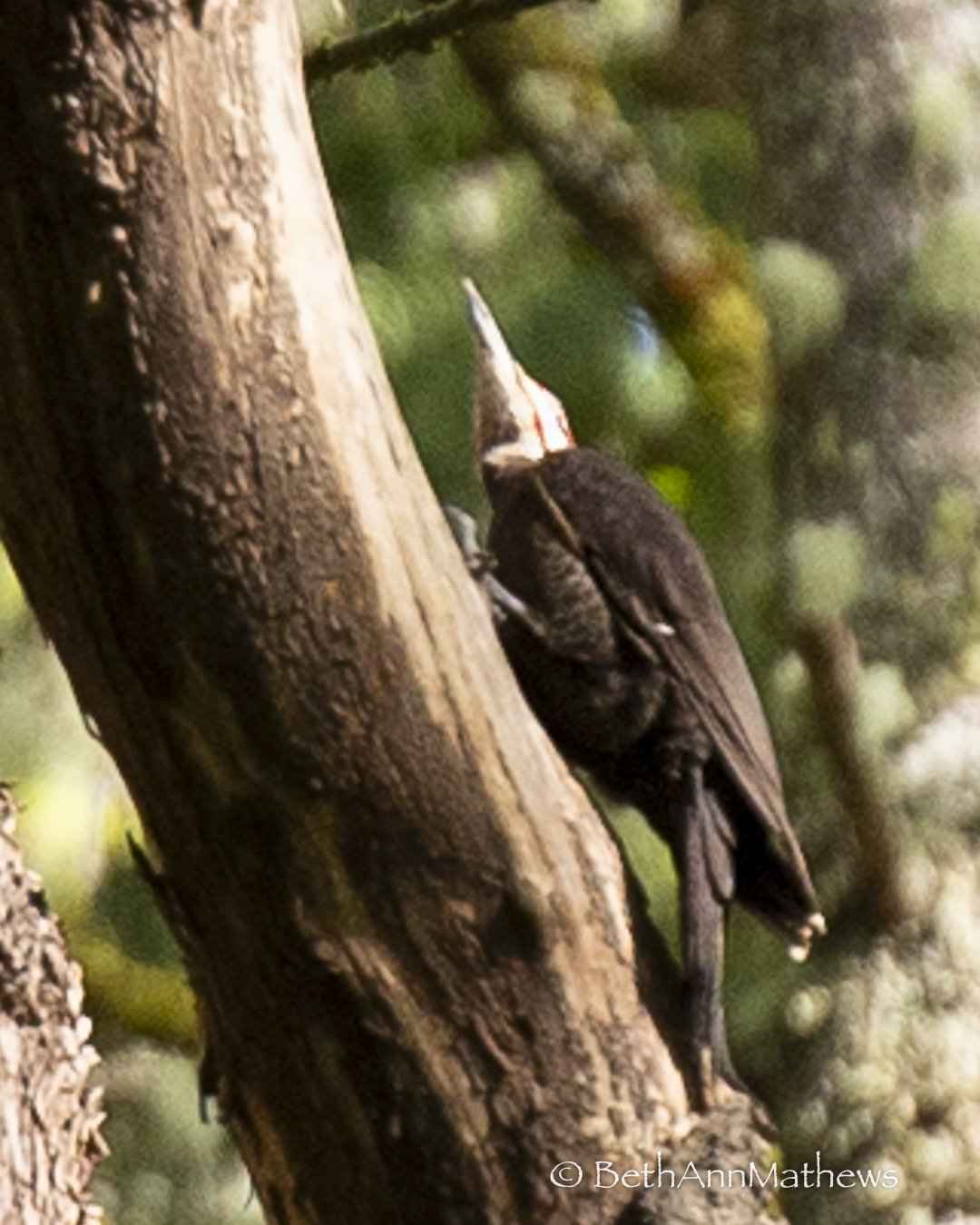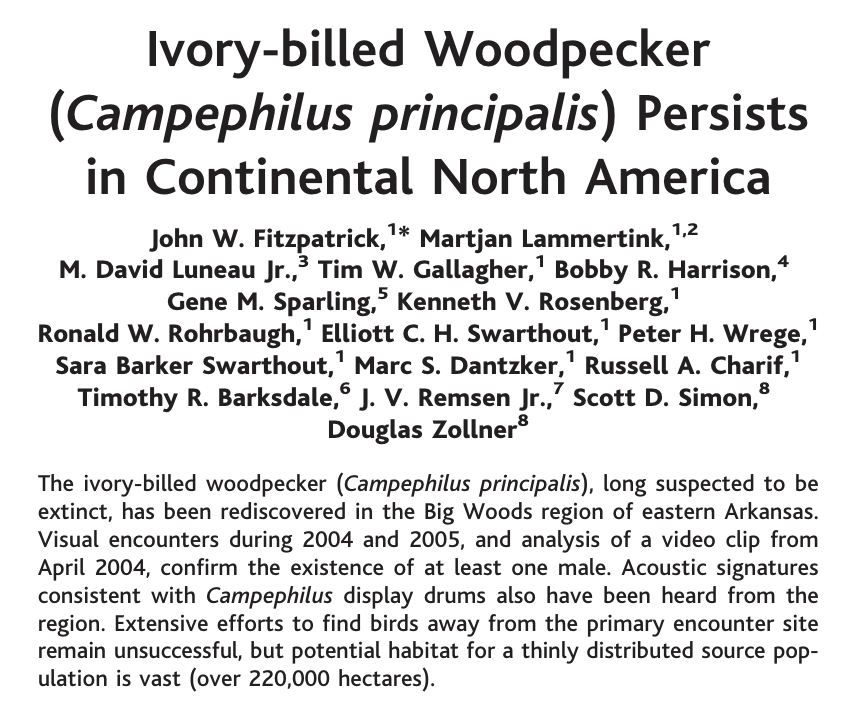What do Pileated Woodpeckers Have to do with “Ghost Birds”?
Recently, Jim and I followed a steep trail down to the coastline in Gazzam Nature Preserve on Bainbridge Island. The towering forest enthralled us. While beach-combing, I heard a sound that tripped a shiver of excitement up my spine.
Gazzam forest. (Photo: iPhone 8+ vertical panorama, BAMathews)
Two weeks earllier, while hiking with naturalist Fawn Bauer-Young at Bloedel Reserve, we noticed a tree snag with rectangular divots chiseled out of it. She mentioned that the size and shape of the holes indicated they were created by pileated woodpeckers.
The sound Jim and I heard, and Fawn’s comment, got me thinking about how much I yearned to observe that species in our new neighborhood.
Why am I smitten with pileated woodpeckers?
In 1980, Pam Osten Young, my supervisor and the Curator of Birds at the Tulsa Zoo, obtained a permit to collect eggs from a pileated’s nest along Oklahoma’s Grand River. After locating the breeding pair, for days she meticulously recorded their behavior at the tree-cavity nest.
When the time was right, she collected their two eggs and delivered them to our awaiting incubator. I remember the moment she arrived in the small room with them, intent and concerned as if delivering something precious—which she was.
By carefully timing the collection, Pam increased the odds that the female would lay a second batch of eggs. Many bird species have physiologically evolved for females to lay a second set of eggs in response to predation.
This method of inducing a second set of eggs, called double-clutching, coupled with hand rearing has been used to assist threatened and endangered bird populations to recover from near extinction, including the California Condor.
One of the woodpeckers we raised from chicks 44 years ago. (Source: Lindholm. 2015. Aviculture at Tulsa Zoo, Part 2)
The immediate objective of Pam’s pioneering project (Osten 1980. Hand raising Pileated Woodpeckers. AAZPA Regional Workshop Proceedings. p.38–40), which I was fortunate to work on, was to learn how to incubate and raise pileated woodpeckers.
The ultimate goal was to apply techniques we tested to assist any breeding ivory-billed parents—should a pair of the highly endangered species ever be discovered—by raising twice as many of their chicks per season.
Think of double-clutching like parents engaging a nanny to help them raise quadruplets—when they expected twins. I absolutely loved my job as one of the zoo’s bird nannies.
Finding the image above online was like discovering a photo of an old friend. The fledglings were exhibited in the Zoo’s open-air Eastern Forest building where they lived 9 and 10 years.
Back to my hike with Jim in Gazzam Preserve: While exploring the beach, I heard a loud drumming. I knew it was a woodpecker, but I wasn’t sure of the species.
Jim and I returned to the trail. Stepping quietly uphill, we froze in our tracks to listen whenever the “rat-tat-tatting” stopped—like kids in a game of Red Light, Green Light. The drumming was loud, yet locating the bird was not easy. Eventually, Jim spotted him. Luckily, I’d brought my long-lens camera.
Male Pileated woodpecker, Gazzam Park Reserve. April 2024. Gender revealed by the red “mustache” feathers.
eBird submission of the recording from my video of the pileated’s drumming.
While pecking the trunk, the bird paused several times with head tilted, as if listening.
Pileated woodpeckers eat primarily carpenter ants, and wood-boring beetle larvae, termites, and other insects (Cornell’s All About Birds).
Long ago, a logger noted that they listened for the sounds of insects in trees before cutting them down.
If they heard them, they flagged the tree to not be harvested. If humans can hear insects, then no doubt woodpeckers use this method to locate their prey.
Why are Ivory-billed Woodpeckers Called The Ghost Bird?
Ivory-billed woodpeckers have been nicknamed King of the Woodpeckers and the Lord God Bird. The nickname Ghost Bird arose as the species became extremely rare. The last confirmed sighting was in 1944.
Ivory-billed Woodpeckers (Campephilus principalis)
SIZE: 18-21 inches long; the largest woodpecker north of Mexico.
DIET: primarily large wood-boring beetle grubs. Its genus, Campephilus, means "lover of grubs"
HABITAT: require large tracts of undisturbed forest with lots of large trees including a significant proportion in stages of decay, to provide a steady source of food.
Have legs and feet specially adapted for perching vertically on tree trunks.
Are closely related to pileated woodpeckers, the second largest woodpecker north of Mexico (SIZE: 16-19 inches).
Are considered extinct by many, but not officially declared so due to a debate over alleged sightings in 2004 and 2005 (Science 2005).
Between 1880 and 1940, “systematic annihilation of virgin tall forests across the southeastern US”—exacerbated by the “relentless pursuit by professional collectors”—led to the near extinction of the last population of ivory-billed woodpeckers in North America.
(Image: Archived ivory-billed specimens. Source: Ghost Bird documentary)
During our 1980 project in Tulsa, time was already running out, but there was still hope that one or more breeding pairs of ivory-billeds might be found.
A pulse of hope for the Ghost Bird
A paper published in the journal Science in June 2005 (Vol 308), with 17 respected authors, stirred up a new flurry of hope and action—and controversy. Had a seasoned ornithologist actually spotted a living ivory-billed woodpecker in Arkansas?
When I read the paper this week, my hope rose to a pounding elation.
What if the methods we perfected at the Tulsa Zoo could help conserve ivory-billed woodpeckers?
In 2009 Scott Crocker released the documentary, “Ghost Bird,” which presents other dimensions to the story—dimensions which deflated my elation.
I recommend Ghost Bird, an important and complex story of extinction, human nature, wildlife management, and conservation. It poses tough questions like, How should we invest limited resources to preserve endangered species?
(I found the 85 min film for free viewing via our library’s Kanopy program.)
Although the likely extinction of the iconic ivory-billed woodpecker is linked to the rapid destruction of its virgin forest habitat, Noel F. Snyder (2007. The Condor.) considers the role of trophy hunters who “shot every last one” the defining factor in wiping them out. From the video, I learned the plight and tragedy of ivory-billed woodpeckers inspired the formation of the Nature Conservancy.
Today, pileated woodpecker populations are considered healthy and the species is wide-spread in North America. Compared to their ivory-billed cousins, they are less specialized in their diet and habitat needs. In addition, they are protected under the US Migratory Bird Act and have likely benefited from the Nature Conservancy’s conservation of forests.
In addition, the development of better and better cameras, which birders now use to confirm sightings of rare species by “shooting” photographs of them, is a welcome replacement of the out-dated compulsion for dead birds as trophies to confirm sightings.
I only recently read up on this topic. I welcome your insights and questions in the comments section.
—Beth
Deep Waters was nominated as a finalist for the 2024 Eric Hoffer First Horizon award “for superior work by debut authors”!
These Awards “honor the memory of the great American philosopher Eric Hoffer by highlighting salient writing, as well as the independent spirit of small publishers.”
Thank you to everyone who has recommended Deep Waters to a friend, to a book club, or posted a review or rating. Word of mouth recommendations and reviews for debut authors are our best way to reach readers.
Available in print, eBook, and Audiobook wherever you prefer to buy books and at libraries (you may have to request the format you prefer).
P.S. Was this email forwarded to you? If so, subscribe here if you’d like to receive infrequent photo essays on wildlife, boating, and a debut author’s journey.











